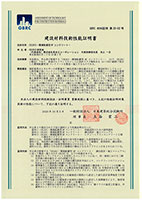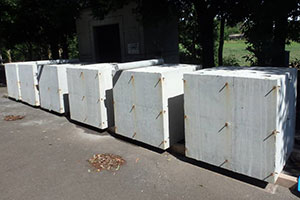This Page is Home![]() Updates
Updates
What's New
Penta-Ocean Construction Co., Ltd.
CELBIC (Environmentally Friendly BF Concrete)
A Group of Thirteen General Contractors Obtained a Certificate of Technical Performance for Construction Materials to Promote its General Use
Tokyo, Japan October 30, 2020 - The CELBIC Study Group (consisting of thirteen companies: Haseko Corporation (organizer), Asunaro Aoki Construction Co., Ltd., Asanuma Corporation, Hazama Ando Corporation, Okumura Corporation, Kumagai Gumi Co., Ltd., Konoike Construction Co., Ltd., Penta-Ocean Construction Co., Ltd., The Zenitaka Corporation, Tekken Corporation, Tokyu Construction, Toyo Construction Co., Ltd, and Yahagi Construction Co., Ltd.) has obtained a Certificate of Technical Performance for Construction Materials (GBRC Material Certification No. 20-02) from General Building Research Corporation of Japan on October 5, 2020 for “Environmentally Friendly BF Concrete (CELBIC)”, a concrete made of ordinary Portland cement mixed with 10-70% granulated blast furnace slag.
CELBIC, an acronym for “Consideration for Environmental Load using Blast Furnace Slag In Concrete”, is an environmentally friendly concrete that reduces carbon dioxide emissions from concrete materials by approximately 9 to 63% while ensuring the quality of concrete required for construction of concrete structures, with aims to contribute to the development of a sustainable society and to improve global environmental problems. CELBIC can be manufactured and shipped as a concrete conforming to JIS A 5308 (ready-mixed concrete) under the responsibility of the thirteen companies participating in the CELBIC Study Group.
In the future, we expect to apply the environmentally friendly CELBIC effectively and efficiently to buildings and other reinforced concrete structures in order to encourage the widespread use.
 CELBIC Certificate of Technical Performance
CELBIC Certificate of Technical Performance
for Construction Materials A mock-up test specimen produced
A mock-up test specimen produced
in the experimental development
■Environmental considerations
Blast furnace slag is made by pulverizing by-product slag produced during steel making process in the blast furnaces of steel mills, and has hydraulic properties. Since the amount of carbon dioxide emitted during the manufacture of blast furnace slag is less than 1/20 than that of ordinary Portland cement, effective use of this granules is desired to reduce the environmental impact.
Granulated blast furnace slag is a concrete material used as a substitute for cement as one of the admixture materials in JIS A 5308 (ready-mixed concrete). In general, it is distributed as Blast Furnace Slag Cement Class B, which is pre-mixed with Portland cement in a determined amount (at 40-45%) at a cement plant.
■Features
CELBIC is produced in a ready-mixed concrete plant using ordinary Portland cement and granulated blast-furnace slag as the concrete material, and according to the application parts, components of the building and the specified performance, 10 to 70% of the cement is replaced with granulated blast-furnace slag.
CELBIC is classified into three classes according to the blast-furnace slag content ratio: Class A, Class B and Class C. Of these, Class A has performance similar to concrete made of ordinary Portland cement, while Class B has performance similar to that of Class B blast-furnace cement. Class C reduces carbon dioxide emissions by more than 60%, although the application at sites are limited. In addition, these three types of CELBICs use the same granulated blast-furnace slag, which alleviates the burden of material management at the ready-mixed concrete plants, and are expected to be applied in a wide range of building structures by taking advantage of the distinctive features of each type.
| Names | Granulated blast furnace slag content ratio (% by mass ) | CO2 emission reduction rate (%) | Applicable parts and components |
| Class A | ≥10 and ≤30 | Approx. 9-28 | Underground structure and superstructures |
| Class B | >30 and ≤60 | Approx. 18-51 | |
| Class C | >60 and ≤70 | Approx. 53-63 | Underground structures or parts/components not in direct contact with the outside air/ the thickness shall be more than 200mm |
[ Names of CELBIC types, granulated blast furnace slag content ratio, CO2 reduction rate, and applicable parts and components ]
■Experimental Developments
In the experimental development, we confirmed the strength development and durability of concrete under various conditions using several kinds of granulated blast furnace slag mainly distributed in Japan, and verified the basic performance of the concrete according to the content ratio of granulated blast-furnace slag.
Based on the results, we determined the selection of the plant and the method of concrete mix design, followed by actual CELBIC manufacturing at the existing ready-mixed concrete plant and conducted construction verification using simulation of existing materials, and finally developed the mix design and construction manual for CELBIC.
